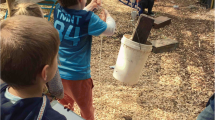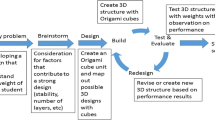Abstract
This case study explores young children’s understanding and application of the concept of volume through the practices of engineering design in a STEM activity. STEM stands for science, technology, engineering, and mathematics. However, engineering stands out as a challenging area to implement. In addition, most early engineering education research centers on curriculum and instruction rather than students’ understanding and application of models and content knowledge to a design project (Johri and Olds, Journal of Engineering Education, 100(1):151–185, 2011). For this study, we created a play-based STEM activity which helps students understand and apply the concept of volume in creating clay boats through the practices of engineering design. Three students voluntarily participated in this study. Data sources included interviews, photocopies of boats, and observation field notes which were analyzed using a comprehensive cross-case analysis. Findings indicate that the common pattern is rather intuitive when students define engineering problems using different criteria. Also, students’ solutions to engineering problems are associated with their experiential ideas of reality. How students express their understanding of volume is correlated to the way of their structuring volume. Lastly, students understand the concept of volume gradually while going through the practices of engineering design. Implications are discussed in terms of how engineering education contributes to students’ understanding of volume.



Similar content being viewed by others
References
Achieve, Inc. (2013). The next generation science standards (NGSS). Retrieved from http://www.nextgenscience.org
Basham, J. D. & Marino, M. T. (2013). Understanding STEM education and supporting students through universal design for learning. Teaching Exceptional Children, 45(4), 8–15.
Battista, M. T. & Clements, D. H. (1996). Students’ understanding of three-dimensional rectangular arrays of cubes. Journal for Research in Mathematics Education, 27(3), 258–292.
Bogdan, R. C. & Biklen, S. K. (2003). Qualitative research for education: An introduction to theories and methods (4th ed.). New York, NY: Pearson.
Bybee, R. W. (2010). Advancing STEM education: A 2020 vision. Technology and Engineering Teacher, 70(1), 30–35.
Carspecken, P. F. (1996). Critical ethnography in educational research. London, UK: Routledge.
Copple, C. & Bredekamp, S. (2009). Developmentally appropriate practice in early childhood programs, serving children from birth through age (3rd ed.). Washington, DC: National Association for the Education of Young Children.
Curry, M. & Outhred, L. (2005). Conceptual understanding of spatial measurement. In P. Clarkson, A. Downton, D. Gronn, M. Horne, A. McDonough, R. Pierce & A. Roche (Eds.), Building connections: Theory, research and practice: Proceedings of the 28th annual conference of the Mathematics Education Research Group of Australasia [MERGA] (pp. 265–272). Sydney, Australia: MERGA.
Elkind, D. (1961). Children’s discovery of the conservation of mass, weight, and volume: Piaget replication study II. The Journal of Genetic Psychology: Research and Theory on Human Development, 98, 219–227.
Gutierrez, K. D. & Rogoff, B. (2003). Cultural ways of learning: Individual traits or repertoires of practice. Educational Researcher, 32(5), 19–25.
Johri, A. & Olds, B. M. (2011). Situated engineering learning: Bridging engineering education research and the learning sciences. Journal of Engineering Education, 100(1), 151–185.
Katehi, L., Pearson, G. & Feder, M. (Eds.). (2009). Engineering in K-12 education: Understanding the status and improving the prospects—A committee report on K-12 Engineering Education for the National Academy of Engineering and National Research Council. Washington, DC: The National Academies Press.
Lee, C. (2006). Language for learning mathematics: Assessment for learning in practice. Buckingham, UK: Open University Press.
Lehrer, R., Strom, D. & Confrey, J. (2002). Grounding metaphors and inscriptional resonance: Children’s emerging understanding of mathematical similarity. Cognition and Instruction, 20, 359–398.
Merriam, S. B. (1998). Qualitative research and case study applications in education. San Francisco, CA: Jossey-Bass.
Nasir, N. S. & Hand, V. (2008). From the court to the classroom: Opportunities for engagement, learning, and identity in basketball and classroom mathematics. Journal of the Learning Sciences, 17(2), 143–179.
National Research Council [NRC]. (2012). A framework for K-12 science education: Practices, crosscutting concepts, and core ideas. Washington, DC: The National Academies Press.
National Science Foundation [NSF]. (2000). Foundations volume 2: Inquiry thoughts, views and strategies for the K-5 classroom. Washington, DC: Author.
Park, M., Dimitrov, D. M., Patterson, L. G., & Park, D. (2016). Early childhood teachers’ beliefs about readiness for teaching STEM (science, technology, engineering, and mathematics). Journal of Early Childhood Research. Advanced online publication. doi:10.1177/1476718X15614040
Patton, M. Q. (2015). Qualitative evaluation and research methods (4th ed.). Los Angeles, CA: Sage.
Piaget, J., Inhelder, B. & Szeminska, A. (1960). The child’s conception of geometry. London, UK: Routledge and Kegan Paul.
Potari, D. & Spiliotopoulou, V. (1996). Children’s approached to the concept of volume. Science Education, 80(3), 341–360.
Sarama, J. & Clements, D. (2009). Early childhood mathematics education research: Learning trajectories for young children. New York, NY: Routledge.
Spradley, J. P. (1980). Participant observation. New York, NY: Holt, Rinehart & Winston.
Stone-MacDonald, A., Wendell, K., Douglas, A. & Love, M. (2015). Engaging young engineers: Teaching problem-solving skills through STEM. Baltimore, MD: Paul H. Bookers.
Streveler, R. A., Litzinger, T. A., Miller, R. L. & Steif, P. S. (2008). Learning conceptual knowledge in the engineering sciences: Overview and future research directions. Journal of Engineering Education, 97(3), 279–294.
Vygotsky, L. S. (1978). Mind in society: The development of higher psychological processes. Cambridge, MA: Harvard University Press.
Yin, R. K. (2003). Case study research design and methods (3rd ed.). Thousand Oaks, CA: Sage.
Zawojewski, J. S., Diefes-Dux, H. A. & Bowman, K. J. (Eds.). (2008). Models and modeling in engineering education: Designing experiences for all students. Rotterdam, The Netherlands: Sense.
Author information
Authors and Affiliations
Corresponding author
Appendix
Appendix
Rubric of understanding of the concept of volume
Beginning | Transitional | Fully developed |
Children provide poor understanding and perception-based understanding that offers naive and perceptional explanation about their boats. Explanation is not clear how the volume is constituted, and how the length, width, and height are related to form the volume of an object. The explanation of its application to real-life situations is rudimentary. They are not able to explain how other impacting factors are related, e.g., shape, physical properties, mass, hollowness, and openness of a boat. | Children provide relation-based understanding that offers perceptional explanation as well as related similar cases of the object. They explain the volume correctly but incoherently. They know the length, width, and height but do not know how they are related to form the volume of a boat. The application to real-life situations is not coherent. They are able to partially explain how other factors are related, e.g., shape and physical properties of a boat. | Children provide conceptual understanding and are able to explain what the volume is, and how the length, width, and height are related to form the volume of an object. They apply the concept to the boat that is constructed with concept-based explanation. They are able to fully explain how other impacting factors are related, e.g., shape and physical properties of a boat. |
Rights and permissions
About this article
Cite this article
Park, DY., Park, MH. & Bates, A.B. Exploring Young Children’s Understanding About the Concept of Volume Through Engineering Design in a STEM Activity: A Case Study. Int J of Sci and Math Educ 16, 275–294 (2018). https://doi.org/10.1007/s10763-016-9776-0
Received:
Accepted:
Published:
Issue Date:
DOI: https://doi.org/10.1007/s10763-016-9776-0




